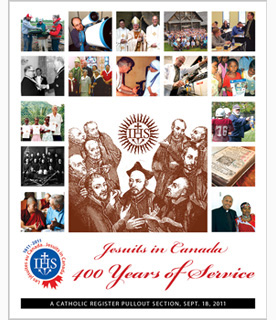Seeing God in all things — from other people to nature and from one profession to the next — was Loyola’s mantra, and therefore, a key part of Jesuit spirituality.
“We don’t have to go looking, we just have to discover… God is already at work,” said Carroll, a former vocations director.
The aim of the Exercises, which are divided into four parts or “weeks,” is true spiritual freedom, he added. Whether they take the form of a three-day retreat, a month-long pattern or an entire lifetime, the Exercises are meant to lead people to a more Christian lifestyle, helping them to discern their own calling.
Fr. Len Altilia, S.J., has seen the effects of the Exercises firsthand. As Jesuit vocations director, he leads retreats formed after them.
“The first (week) is to recognize in our humanity how much God has forgiven us as we acknowledge the reality of sin in our life,” said Altilia. “God still chose to reach out to us and call us to holiness and save us.”
From that acknowledgement, Altilia explained, the Exercises go on to explore the person and life of Jesus in the second week, His suffering and death in the third, and finally, the power of the Resurrection in the last. The final contemplation, he said, is an exercise of seeking to love as God loves.
By the end of the pattern, those who undertake the Exercises are exposed not only to Loyola’s focus on seeing God everywhere, but to the motto of the Jesuits, “for the greater glory of God.” Also a mantra of Loyola’s, the phrase comes from the Latin Ad Majorem Dei Gloriam, often shortened to AMDG.
It’s a sentiment that still resonates through Ignatian spirituality today. At many Jesuit schools, students are asked to write the motto’s initials at the top of their papers, reminding them that even their schoolwork should serve God.
And it was those Jesuit schools that attracted both Altilia and Carroll to religious life in the Society of Jesus. About to graduate, Carroll thought of becoming a teacher. He was somewhat underwhelmed by the conversations he had about the profession with his lay teachers, but he didn’t let that deter him.
“Then I spoke to my Jesuit teachers,” he said. “When they spoke, I had a sense of ‘Aha!’ ”
Caroll’s Jesuit teachers’ zeal and attitude towards their work fell in line with why he wanted to become a teacher, and so he joined the Society.
But whether a person chooses to live a lay or a religious life, Altilia pointed out, they have the same access to Ignatian spirituality. After all, the spirituality has its roots in laity.
“The spirituality of the Exercises was intended for lay people,” said Altilia. “Ignatius was a layperson, the first people he shared the Exercises with were laypeople.”
Because of its guiding power in helping people discern their calling, Ignatian spirituality is often referred to as a spirituality of decision-making. For Jesuits, the correct decision is that which serves God the most. And it doesn’t end there; whatever one does, the Jesuits believe, there is more good to be done. This type of spirituality is tireless and never-ending; it pervades everyday life and never ceases.
“You keep striving for something that manifests God,” said Altilia. “You are good, but you have to be better.”
Loyola’s Spiritual Exercises still at Jesuits’ core
By Luc Rinaldi, The Catholic RegisterIgnatian spirituality, the foundation of the largest religious order of men in the world, had humble and unusual beginnings: three lay students sharing a dorm room at the University of Paris.
But these were no ordinary students. The first was Ignatius of Loyola, a converted soldier who had encountered God in a vision, and the other two were as deeply rooted in their faith as he. In that dorm room, Loyola led Francis Xavier and Peter Faber through the Spiritual Exercises, a 30-day prayer pattern he had developed. That same pattern is still used today, and is at the core of the Society of Jesus.
“The Spiritual Exercises becomes a means of knowing, experiencing, understanding and growing in intimacy with Jesus Christ,” said Fr. Bernie Carroll, S.J., director of the Martyrs’ Shrine in Midland, Ont. “You come to the end of it and realize God is in everything.”
Please support The Catholic Register
Unlike many media companies, The Catholic Register has never charged readers for access to the news and information on our website. We want to keep our award-winning journalism as widely available as possible. But we need your help.
For more than 125 years, The Register has been a trusted source of faith-based journalism. By making even a small donation you help ensure our future as an important voice in the Catholic Church. If you support the mission of Catholic journalism, please donate today. Thank you.
DONATE
